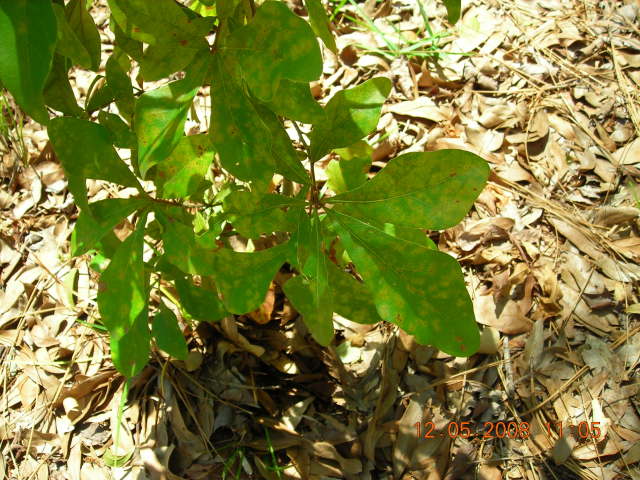Question Oak troubles
Oak troubles
QUESTION: Our two large oak trees have had for years what I've been told is a fungus
that won't kill them. I've also been told that they are too large to be
reasonably sprayed. (Laurel (?) oak pictures.) Nearby is a 2 ft Water Oak
volunteer that is beautifully shaped. Early Spring (Florida) it developed
something that looks similar but not the same. The new leaves coming out
do not have it. (last pictures) My neighbor wants the little tree, but is
concerned that her trees will develop whatever it is that is on my trees. What
is it? The same or not? Can I treat the little tree? She lives 1/2 acre away. Is
it safe for her to take it? Should I do something for my big trees? (picts
taken 5-12-2008)
ANSWER: The picture you attached is not too clear. If you have more picture that are closer up of the leaf can you send them to
[email protected] and I will try to id the problem.
From what you described it seems to be a leaf spot fungus or an insect gall. Neither will cause any health problems to the tree except make the leaves look speckled. There is no need to treat for these. Places send the picture and I will see if I can see anything else.
Thanks.
---------- FOLLOW-UP ----------
 young tree
young tree
QUESTION: Here is the other of the young tree. If this doesn't give you what you need, i
will
be glad to simply take some leaf pictures.
Thank you VERY much.
AnswerI am sorry I did these backwards This picture is the leaf blisters the other is a gall formed by an insect called a gall wasp.
Galls are irregular plant growths which are stimulated by the reaction between plant hormones and powerful growth regulating chemicals produced by some insects or mites. Galls may occur on leaves, bark, flowers, buds, acorns, or roots. Leaf and twig galls are most noticeable. The inhabitant gains its nutrients from the inner gall tissue. Galls also provide some protection from natural enemies and insecticide sprays. Important details of the life cycles of many gall-makers are not known so specific recommendations to time control measures most effectively are not available.
Gall makers must attack at a particular time in the year to be successful. Otherwise, they may not be able to stimulate the plant to produce the tissue which forms the gall. Generally, initiation of leaf galls occurs around "bud break" or as new leaves begin to unfold in the spring.
Twig and Stem Galls
Twig and stem galls, such as the gouty oak gall and horned oak gall, are solid, woody masses that can girdle branches or make them droop from the sheer weight of the heavy growths. The galls can grow to more than 2 inches in diameter. Horned oak galls can be found on pin, scrub, black, blackjack, and water oaks while gouty oak galls occur on scarlet, red, pin or black oak.
These galls have a long and complex development that takes two or more years to develop. The first stage is a blister-like leaf gall that occurs along larger leaf veins. The second stage is a knotty twig gall that is started in mid-summer and becomes fully mature in 1 to 2 years. Adults emerge in the spring. Gouty oak twig galls are smooth; horned oak galls have horn-like projections. One female wasp can emerge from each horn.
Generally, insecticidal control is not satisfactory because the wasps are physically protected within the galls. Correctly timing applications to provide effective preventive control is difficult. Where practical, pruning of infested twigs may help to reduce the problem on lightly-infested trees.
I would just prune these of IF they concern you if not let them be. The population of the wasp varies greatly each year so next year you may not see any.
Sorry about the mix up of the pictures--the galls on the stem are the gall wasp the spots on the leaves are the blister fungi.







